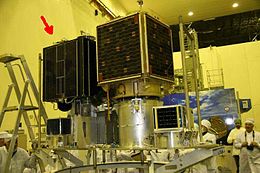EgyptSat 1

EgyptSat 1 (left) and Saudi Sat 3 (right)
|
|
| Mission type | Remote sensing |
|---|---|
| Operator | NARSS |
| COSPAR ID | 2007-012A |
| SATCAT № | 31117 |
| Website | www |
| Mission duration | 5 years |
| Spacecraft properties | |
| Bus | MS-1TK |
| Manufacturer | Yuzhnoye Design Bureau |
| Launch mass | 165 kilograms (364 lb) |
| Power | 65 watts |
| Start of mission | |
| Launch date | APRIL 17, 2007, 07:02 UTC |
| Rocket | Dnepr |
| Launch site | Baikonur 109/95 |
| Contractor | ISC Kosmotras |
| End of mission | |
| Last contact | July 19, 2010 |
| Orbital parameters | |
| Reference system | Geocentric |
| Regime | Sun-Synchronous |
| Perigee | 658 kilometres (409 mi) |
| Apogee | 666 kilometres (414 mi) |
| Inclination | 98.1 degrees |
| Main Push broom scanner | |
| Name | EgyptSat 1 |
| Resolution | 7.8 metres (26 ft) (MBEI) 39 metres (128 ft) (cross-track) x 46 metres (151 ft) (along-track) (IREI) |
EgyptSat 1 or MisrSat-1 is Egypt's first Earth remote sensing satellite. This satellite was jointly built by Egypt's National Authority for Remote Sensing and Space Sciences together with the Yuzhnoye Design Bureau in Ukraine and was launched on board a Dnepr rocket on 17 April 2007 from the Baikonur Cosmodrome.
The effort was spearheaded by Dr. Aly Sadek, chairman of the Egyptian Council for Space Science and Technology Research. It in many ways was considered a huge step for the Egyptians since it marked the first time they opted for technology transfer during the manufacturing the satellite rather than simply purchasing one (as in case of the Nilesat satellites). On 23 October 2010, the National Authority for Remote Sensing and Space Sciences announced that control and communication with the satellite had been lost since July 2010.
In 2001, Egypt posted an international tender for the development of the first Egyptian satellite for the observation and remote sensing and bidders from Ukraine,UK, Russia, Korea and Italy competed for the deal.
on June 26, 2001 KB Yuzhnoe design bureau from Ukraine announced winner and on October 24, a contract had been signed in Egypt.
A consortium consisted of KB Yuzhnoe design bureau and sub-contrators Ukrainian companies:
The Egyptian space program in fact started in the nineteen fifties but it wasn't until the establishment of the Egyptian Space Council in 16/5/1998 and the approval of a year later in 26/5/1999 of the Egyptian Space Program within the National Authority of Remote Sensing and Space Sciences.
The objective of the three satellites is to provide comprehensive images for Egyptian land
Egyptsat 1 is considered a miniaturized satellite weighing 100 kg and is carrying two devices:
...
Wikipedia
